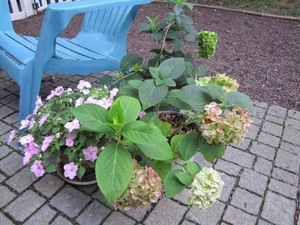The beautiful hydrangea is one flowering bush that generates many questions, some gardener’s have great success growing hydrangeas, while others struggle just to keep their hydrangea alive. I was in the latter group for years, actually killing a few hydrangeas along the way with trial and error gardening methods. My neighbor gave me a small hydrangea bush along with some growing advice and I now have thriving hydrangea bushes.
The ‘hydra’ in hydrangea indicates the flowering bush needs plenty of water. Water is lost at a rapid rate through the big, broad leaves of the hydrangea and the bush suffers from dehydration easily in the summer heat. Water deeply at least twice per week during the summer, more often if the leaves on your hydrangea are wilted.
Feed your hydrangea three times per year, March. May and July, with a light side application of a balanced fertilizer. 10-10-10 granulated fertilize feeds the hydrangea well and you can apply this type of fertilize right on top of the mulch around the hydrangea. The frequent watering will dissolve the granulated fertilize and it will gradually seep into the soil providing a steady diet for your hydrangea.
A hydrangea bush will grow best in partial shade where it will be shielded from the intense heat of the afternoon summer sun. A location that will receive the morning sun and a total of 6 hours of sun per day is the optimum location.
Pruning a hydrangea should be done soon after the blooms have faded, and most hydrangea varieties need to be pruned before mid-August or your risk cutting off next year’s buds. Pruning off the old hydrangea blooms is not the same as pruning the entire bush. Hydrangeas produce blooms on old wood, the stems the bush formed last year, so the hydrangea blooms won’t appear next year on the same stems they did this year. Dead-heading the spent blooms will not impair your hydrangea’s blooming capacity next year. Overall hydrangea bush pruning to remove dead or diseased stems or unwanted growth should be done when you remove the spent blooms. Use sharp pruning shears and make clean cuts.
Propagation of a hydrangea bush is quite simple, it’s called ‘layering’. Dig a trench near the base of your hydrangea, 3 inches deep, 1 inch wide and 5-6 inches long. Choose a long limb near the bottom of the hydrangea and bend the limb down into the trench. On a portion of the limb that rests within the trench, carefully remove 1 inch of bark all the way around the limb with a knife. Place the limb in the trench and cover with soil to propagate. You will need between 6-12 inches of the limb tip sticking out of the trench, and you may have to place a small rock on the buried portion of the limb to keep it in the trench soil.
The portion of the limb where you removed the 1 inch of bark will form a new root system in the trench. Leave the hydrangea limb buried until the following growing season. When the limb begins to show new leaf growth, sever the limb from the parent hydrangea bush with pruning shears and gently dig your new propagated hydrangea bush up, keep as much soil intact around the new root system and transplant.





